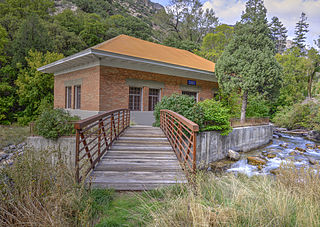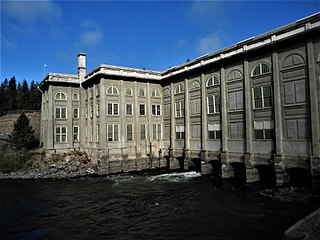
The National Register of Historic Places in the United States is a register including buildings, sites, structures, districts, and objects. The Register automatically includes all National Historic Landmarks as well as all historic areas administered by the U.S. National Park Service. Since its introduction in 1966, more than 90,000 separate listings have been added to the register.
The Snake River Ranch, near Wilson, Wyoming, is the largest deeded ranch in the Jackson Hole area. The ranch buildings are grouped into three complexes comprising headquarters, residential and shop complexes. The ranch combined two neighboring homesteads and was first owned by advertising executive Stanley B. Resor and his wife, Helen Lansdowne Resor. The Resors used the property as a vacation home, but the ranch was also a full-time, self-sustaining operation.

Milner Dam is a rockfill dam near Burley in south central Idaho. It impounds the Snake River in a reservoir named Milner Lake. The dam spans the river across two islands, with three embankments.

Santeetlah Dam is a hydroelectric development on the Cheoah River in Graham County, North Carolina. The dam together with a pipeline/tunnel facility, and a powerhouse form the Santeetlah Development. The Santeetlah powerhouse is located on the left bank of the Cheoah Reservoir portion of the Little Tennessee River five miles (8 km) upstream of the Cheoah Dam.

Liberty Park is a popular public urban park in Salt Lake City, Utah. It is the city's second-largest public park, at 80 acres (32 ha), being surpassed only by Sugar House Park which has 110.5 acres (44.7 ha). The park features a pond with two islands, and is also the location of Tracy Aviary. The park is listed on the National Register of Historic Places (NRHP) and it includes the Isaac Chase Mill, which is also NRHP-listed.

Hardy Dam is an earth-filled embankment dam and powerplant complex on the Muskegon River in Big Prairie Township, Newaygo County, Michigan. At the time of its completion, it was the largest earthen dam in North America east of the Mississippi. Its impoundment forms a lake with over 50 miles of shoreline. The dam impounds a reservoir with a surface area of 4,000 acres and its power plant has an installed capacity of 31.5 MW.

The Occum Hydroelectric Plant and Dam is a historic hydroelectric plant and dam north of Bridge Street on the west side of the Shetucket River in Norwich, Connecticut. The facility includes a rare surviving partial example of a large-scale dam built for a textile mill in 1865, and an early example of a hydroelectric power generation facility established in 1934. It is one of a small number of surviving hydroelectric plants in the state which was built before 1940. The complex was listed on the National Register of Historic Places in 1996.

The Stevenson Dam Hydroelectric Plant is a hydroelectric power plant located on the Housatonic River at the boundary between the towns of Monroe and Oxford, Connecticut. The Connecticut Light and Power Company began construction in 1917 and FirstLight Power has since gained ownership. It was listed on the National Register of Historic Places in 2000 and is considered to have high hazard potential by the National Inventory of Dams. The site includes three contributing structures: the Stevenson Dam, the Stevenson Dam Bridge, and the Stevenson Powerhouse.

The Centennial Work Center in Medicine Bow National Forest near Centennial, Wyoming was built in 1938. It was built to replace the nearby Centennial Ranger Station. It was designed by USDA Forest Service, Region 2 in USFS rustic architecture and served as a government office. It was listed on the National Register of Historic Places for its architecture. The listing included three contributing buildings, a bunkhouse, a combined office and bunkhouse, and a garage, on 5 acres (2.0 ha).
The Keystone Work Center in Medicine Bow National Forest near Albany, Wyoming was built in 1941. It was listed on the National Register of Historic Places in 1994 for its architecture. It was designed by architects of the U.S. Forest Service in a standard plan using log cabin rustic style. The NRHP listing included four contributing buildings on an area of 20 acres (8.1 ha).

The Devil's Gate-Weber Hydroelectric Power Plant was built in 1909–1910 on the Weber River in northeastern Utah, United States, about 10 miles (16 km) southeast of Ogden. It was built by the Utah Light and Railway Company under the direction of E.H. Harriman, a director of the Union Pacific Railroad. It was one of the first powerplants in Utah designed to feed an electrical grid rather than as a source of power of a single locality.
Architects of the National Park Service are the architects and landscape architects who were employed by the National Park Service (NPS) starting in 1918 to design buildings, structures, roads, trails and other features in the United States National Parks. Many of their works are listed on the National Register of Historic Places, and a number have also been designated as National Historic Landmarks.

The Upper American Fork Hydroelectric Power Plant Historic District is a 1.5-acre (0.61 ha) historic district in American Fork Canyon in northeastern Utah County, Utah, United States, that is listed on the National Register of Historic Places (NRHP).

The DML Butler Bridge is a historic bridge over the North Platte River in Carbon County, Wyoming, United States, that is listed on the National Register of Historic Places (NRHP).

Granger Station State Historic Site, also known as Granger Stage Station, South Bend Station and Ham's Fork Station, is a state park in Granger, Wyoming, United States, that is listed on the National Register of Historic Places (NRHP).

The Eklutna Power Plant, also referred to as Old Eklutna Power Plant, is a historic hydroelectric power plant on the Eklutna River in Anchorage, Alaska. Located about 5 miles (8.0 km) downstream of the more modern new Eklutna Power Plant, it was built in 1928–29 to provide electrical power to the growing city, and served as its primary power source until 1956. The facilities include two dams, a tunnel and penstock, and a powerhouse. The main dam, Eklutna Dam, located at the northwestern end of Eklutna Lake, was built in 1941 to replace a series of temporary structures built after an earthen dam failed before the plant began operation. The diversion dam, a concrete arch dam, is located 7 miles (11 km) downstream from the lake, and provides facilities for diverting water into the tunnel. The tunnel is 1,900 feet (580 m) long, and is terminated in a penstock, a structure designed to raise the water pressure. The powerhouse is a concrete-and-steel structure completed in 1929. The diversion dam removal was completed in 2018 to allow for the passage of salmon.

The Houghtonville Historic District encompasses a cluster of residential properties that are all that remain of one of the early industrial areas of Grafton, Vermont. Located west of Grafton Village on Houghtonville Road, it includes ten well-preserved 19th-century houses, some located on properties where early mills once stood. The district was listed on the National Register of Historic Places in 2015.

The Little Falls Hydroelectric Power Plant, on the Spokane River near Reardan, Washington, about 30 miles (48 km) west of Spokane was built during 1907–10. It was listed on the National Register of Historic Places in 1988. The listing included one contributing building and seven contributing structures on 12 acres (4.9 ha). The area spans the border of Lincoln County, Washington and Stevens County, Washington.

Long Lake Hydroelectric Power Plant, on the Spokane River near Ford, Washington, was built in 1915. It was listed on the National Register of Historic Places in 1988. The listing included one contributing building and five contributing structures on 15 acres (6.1 ha) in Lincoln County, Washington and Stevens County, Washington.


















